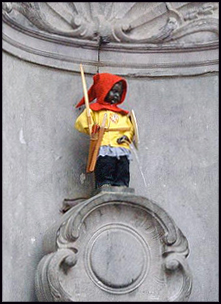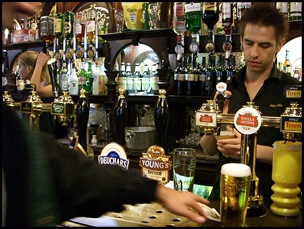 By PAT HARTMAN
By PAT HARTMAN
News Editor
Brussels, says Rick Steves in the pages of The Seattle Times, is one of the great travel secrets of Europe. He goes on to illustrate why, with such examples as:
Belgian fries (“frites”) taste so good because they’re deep-fried twice – once to cook, and once to brown. The locals dunk them in mayonnaise, especially delicious if the mayo is flavored with garlic. My favorite budget meal in Brussels is having simple pub grub in an atmospheric old pub with a gaggle of “beer pilgrims,” who’ve flocked here from around the world…
Which is all very nice, but what made our ears prick up was a mention of the stone mascot of Brussels, the Mannekin Pis statue, located near the Town Hall. Steves informs us that its extensive wardrobe comes from all over the world, as various cities send costumes as gifts, which are displayed in the City Museum. How do they get the right measurements? But that’s neither here nor there.
The astute reader has noticed that certain themes run through the work of Kevin Dolgin and thus, through this column. Statues are one of those themes, and he has written about this archetypal piece of functional sculpture. In The Third Tower Up From the Road, he advises:
Plan on spending a good 12 minutes at the statue of Manneken Pis, a minuscule bronze of a small boy peeing into a fountain … if you’re lucky he’ll be dressed up as anything from a medieval pikeman to Elvis Presley. The residents of Brussels get their kicks as best they can.
When they’re not dressing the thing up in goofy costumes, they’re stealing it. Over the centuries, seven Mannekin Pis thefts have stained the city’s honor. Like any urban hero worthy of the name, the peeing boy is the subject of much folklore. It seems there once was an aristocratic toddler, protected from battle by soldiers who stashed him in a tree, from which he peed on the enemy troops. Or, not from a tree, peed on the fuse of the dynamite planted by the enemy at the city wall. Or merely got lost, and everybody in town helped look for the kid, and he was found doing you-know-what, and his rich dad commissioned the statue in honor of the boy’s safe return. Please, feel free to make up your own Mannekin Pis legend and send it to us.
The locals really get into the spirit of things, with ceremonies where beer is pumped through you-know-where and handed out to passers-by (there’s a joke in there somewhere) to the accompaniment of live brass band music. This is definitely worth the trip. You might think that one Mannekin Pis would be enough, but no, the darn things are all over the place. Several other Belgian towns have their own, and in one of them he’s known as Il Gamin Quipiche. In France, they call him Le Petit Julien. The town of Tokushima, Japan, has a peeing boy statue that was presented to it by the thoughtful folks at the Belgian embassy. Even Rio de Janeiro has one. And that’s not even counting the millions of Mannekin Pis lawn ornaments all over the globe, perhaps even more numerous than garden trolls.
While Kevin implies that the peeing boy is one of only three tourist attractions in Brussels, this is clearly an underestimation. The city boasts many fine cultural destinations, including the Celebrity Underwear Museum, as we learn from SpiegelOnline, in an article that must be read to be believed. The museum was founded by a manic and rather infamous artist named Jan Bucquoy. Apparently the collection’s piece de resistance is… a pair of boxer shorts once worn by a finance minister. Like Kevin says, “The residents of Brussels get their kicks as best they can.”
photo courtesy of fiona bradley, used under this Creative Commons license

